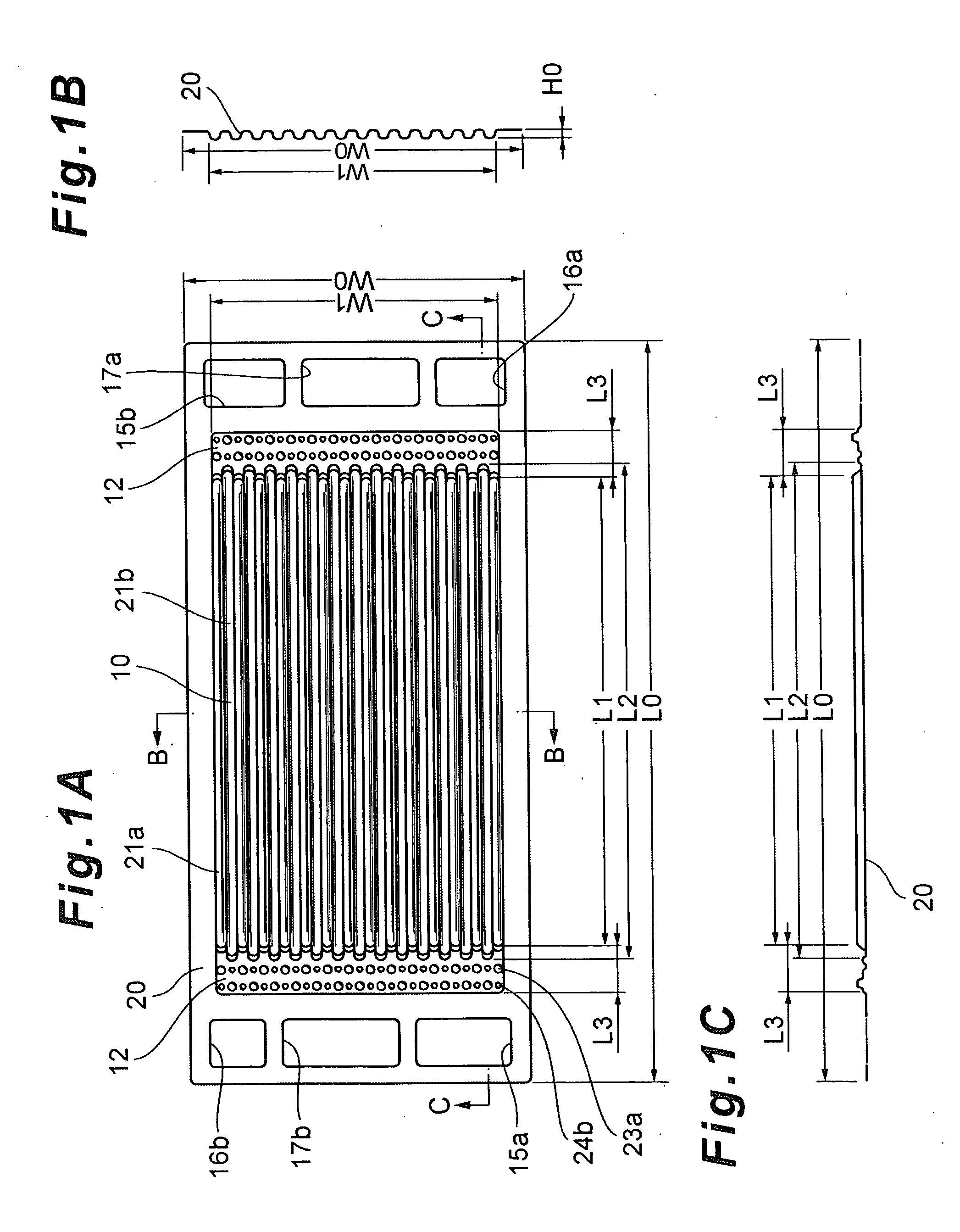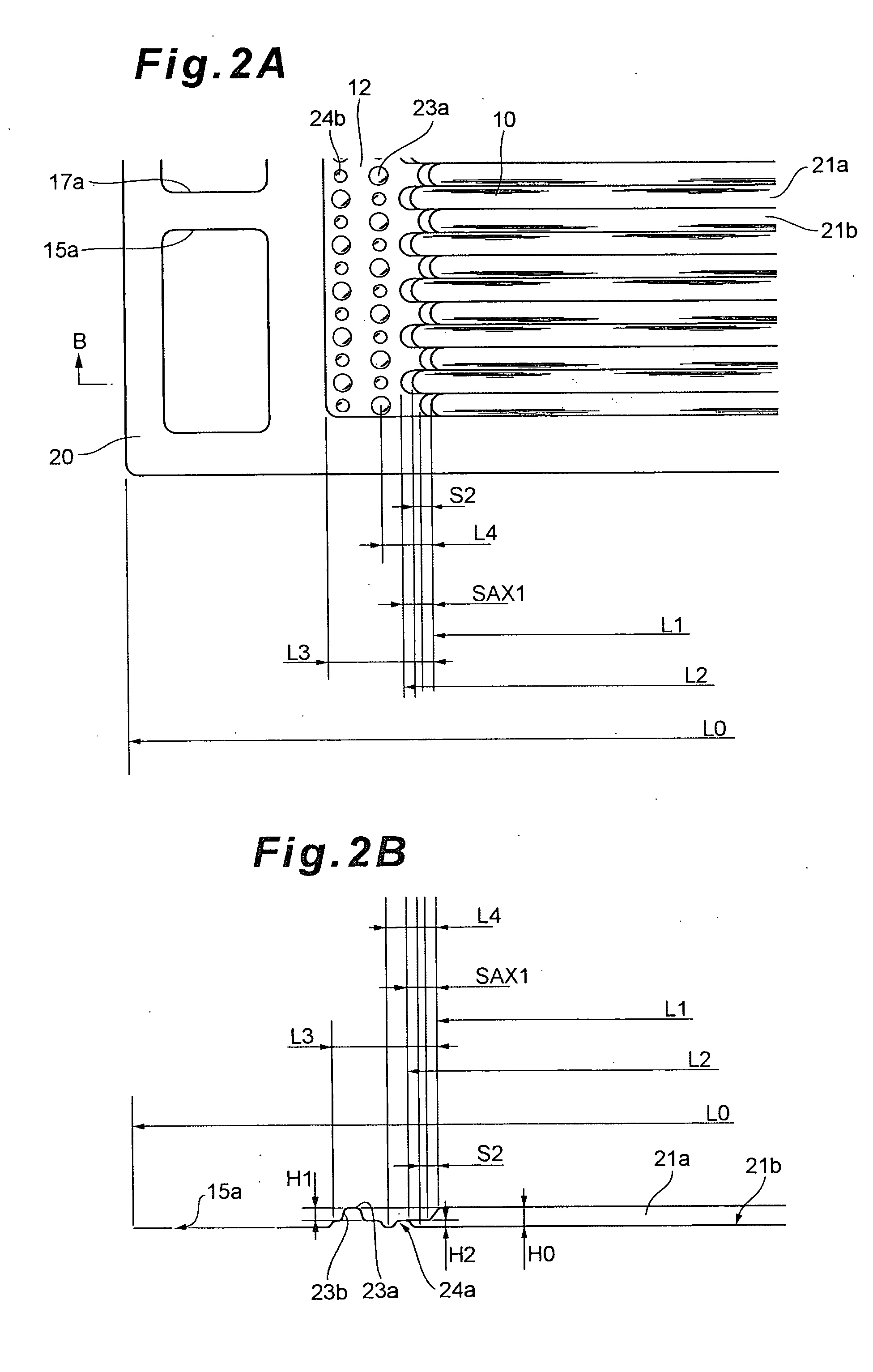Separator of Fuel Cell
a fuel cell and separator technology, applied in the field of separators of fuel cells, can solve problems such as differential pressure (pressure loss) especially around boundary portions, and achieve the effect of convenient securemen
- Summary
- Abstract
- Description
- Claims
- Application Information
AI Technical Summary
Benefits of technology
Problems solved by technology
Method used
Image
Examples
first embodiment
[0050]First, FIG. 1A to FIG. 1C show a separator 20 provided with a straight type gas channel 10. As described above, ends of this separator 20 are provided with inlet manifolds 15a, 16a and 17a and outlet manifolds 15b, 16b and 17b of various fluids (an oxidizing gas, a fuel gas and cooling water). Moreover, both ends of the gas channel 10 are provided with distribution channels 12 for distributing a gas to the gas channels 10 (see FIG. 1A, FIG. 2A, etc.). It is to be noted that a portion where the gas discharged from the gas channel 10 joins will also be referred to as the distribution channel 12 in the present embodiment. That is, in this case, the distribution channel 12 does not substantially distribute the gas, but has a symmetric structure, and the gas can be supplied in either direction. Therefore, in the present embodiment, both the portions are referred to as the “distribution channels” for the sake of convenience.
[0051]This distribution channel 12 is provided with a plura...
second embodiment
[0062]FIG. 5A to FIG. 5C show one example of a structure for reducing a differential pressure in a case where cooling water is introduced from a distribution channel 12 to a linear channel. Contrary to the separator shown in FIG. 3A and the like, this separator 20 satisfies a relation L1>L2. That is, a total length L2 of a concave groove 21b is shorter than a total length L1 of a convex rib 21a, and a terminal end of the convex rib 21a is positioned closer to the distribution channel 12 than a terminal end of the concave groove 21b (see FIG. 5A to FIG. 5C). Here, the convex rib 21a and the concave groove 21b are formed symmetrically with respect to center lines, respectively, and hence eventually, the convex rib 21a in one end of the separator 20 of the present embodiment is formed to be longer than the concave groove 21b as much as SBX1=(L1−L2) / 2 (see FIG. 5A, etc.).
[0063]Moreover, a structure around the terminals of the convex rib 21a and the concave groove 21b in the present embo...
third embodiment
[0069]Next, a case where the present invention is applied to a separator 20 having serpentine type channels will be described (see FIG. 6, FIG. 7).
[0070]FIG. 6 and FIG. 7 show one example of the serpentine type separator 20 viewed from the side of a gas (an oxidizing gas or a fuel gas) channel 10. Ends of this separator 20 are provided with inlet manifolds 15a, 16a and 17a and outlet manifolds 15b, 16b and 17b of various fluids (the oxidizing gas, the fuel gas and cooling water) in the same manner as in the above embodiments (see FIG. 6). In the separator 20 of the present embodiment, distribution channels 12 of the gases are provided in the vicinities of the inlet manifolds 15a, 16a and 17a and the outlet manifolds 15b, 16b and 17b of various fluids (the oxidizing gas, the fuel gas and the cooling water), respectively, and a plurality of straight gas channels 10 (and cooling water channels 36) constituted of a plurality of parallel convex ribs 21a and concave grooves 21b are provid...
PUM
| Property | Measurement | Unit |
|---|---|---|
| area | aaaaa | aaaaa |
| total length | aaaaa | aaaaa |
| height H1 | aaaaa | aaaaa |
Abstract
Description
Claims
Application Information
 Login to View More
Login to View More - R&D
- Intellectual Property
- Life Sciences
- Materials
- Tech Scout
- Unparalleled Data Quality
- Higher Quality Content
- 60% Fewer Hallucinations
Browse by: Latest US Patents, China's latest patents, Technical Efficacy Thesaurus, Application Domain, Technology Topic, Popular Technical Reports.
© 2025 PatSnap. All rights reserved.Legal|Privacy policy|Modern Slavery Act Transparency Statement|Sitemap|About US| Contact US: help@patsnap.com



